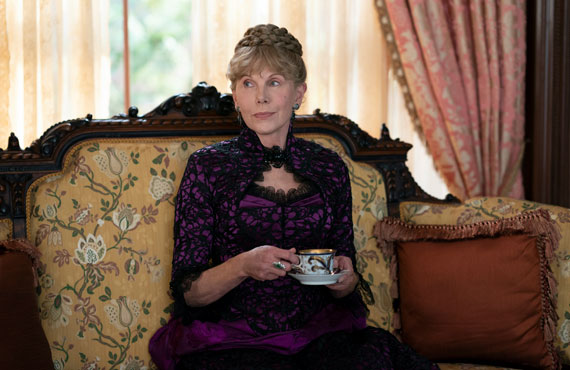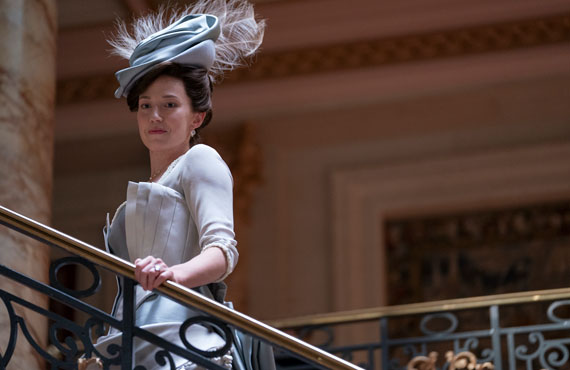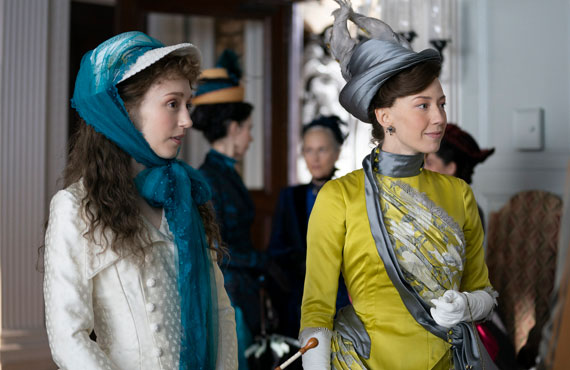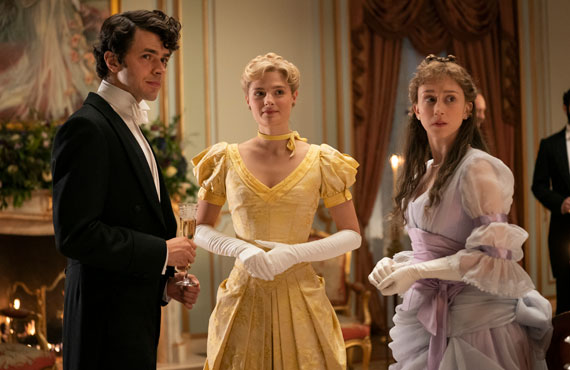A Fashion Guide to HBO's The Gilded Age Premiere
-
 Photos: HBO
Photos: HBOLong before Fashion Week came into existence, New York City was already at the forefront of cutting-edge style, and those with social status set the sartorial tone. Downton Abbey's Julian Fellowes has turned his attention from the upstairs/downstairs world of aristocratic England at the start of the 20th Century to the American Gilded Age, which saw legacy families clash with wealthy newcomers. Monday night's premiere of HBO's The Gilded Age was quick to establish Manhattan’s elite who control the social scene. Money can’t buy status or adulation, but booming success does have its couture benefits.
Boasting a cast packed with favorites and costumes designed by Kasia Walicka-Maimone, the show's pilot episode set the scene: a period of immense economic change and innovation that challenged the status quo through railroads, architecture, and even choice of garment. Recognizable names like the Astors feature alongside the fictional characters all vying for a piece of this expanding pie. At the center of this story is Marian Brook (Louisa Jacobson) who has to move from rural Pennsylvania to live with her old money aunts in New York City after the death of her father. A whole new set of rules await the young woman and she is quickly thrust into the middle of a battle between her stubborn Aunt Agnes van Rhijn (Christine Baranski) and the ambitious Bertha Russell (Carrie Coon).
Grab your fanciest hat and join us for this breakdown of ten sumptuous looks from the first episode of The Gilded Age:
Marian Brook and Peggy Scott’s Travel Attire

Marian’s journey to New York City in “Never the New” gets off to a terrible start when her purse is stolen and she has to rely on a stranger in order to board her train. Tickets sent by her aunt and all of her money (totaling $30) were in the bag that gets snatched from under her nose. Marian’s father wasn’t as flush with cash as she had believed, which is why she is moving to New York in the first place. The all-black ensemble isn’t early Goth or an attempt to be chic but reflects her mourning status. Peggy Scott (Denée Benton) is on her way home to Brooklyn, and her neat brown ensemble is torn by Marian during the fight on the platform that led to her current predicament. Marian’s naivety is as pronounced as her grieving aesthetic, and she doesn’t immediately clock why Peggy and the other Black passengers aren’t getting on the train at the same time as everyone else.
Comfort is key for a long journey and while the undergarments of this time are not ideal for a 12-hour voyage, there is a lot to be said about Peggy’s ensemble. Style-wise, it establishes Peggy as a character whose clothes aren’t too far from contemporary silhouettes or patterns. Sure the bustle has long gone out of fashion, but the brown coat, plaid print, and small black travel case are timeless.
Meeting Aunt Agnes and Aunt Ada

Marian’s aunts couldn’t be more different in personality and dress, which sees Ada Brook (Cynthia Nixon) embrace orange and brown tones throughout the first episode. Her spinster status is well-advertised, and the often cheerful color palette she embraces offsets her “sad sister” reputation. It also makes Ada hard to miss when she peeks behind her curtains at the new neighbors moving in. Subtle she is not, and this head-to-toe orange pulls focus when Marian and Peggy arrive.
Agnes is quick to assess her niece’s mourning garb and calls for an immediate wardrobe overhaul and a trip to her dressmaker. Everything Marian says or does is a reflection on them, and this includes her attire. Agnes is as subtle as Ada’s dress when she explains why she must embrace cheerful colors, as she aims to quickly find a suitable bachelor for Marian to hitch her wagon to. Black is not considered appealing because who wants to engage with a sadsack? Living under this roof means adhering to old money rules and that includes the makeover she didn’t ask for.
Aunt Agnes’ Jewel Tones

Whereas Ada’s signature shades are warm, Agnes’s stern exterior is matched by the jewel tones paired with black lace detailing. Yes, Agnes is very much of the “do what I say” school of fashion advice. Of course, this choice is informed by her widow status, and while her deceased husband sounds like a terrible person, it isn’t going to stop Agnes from keeping up with etiquette.
Every inch of Baranski as Agnes feels like she is judging you, and her perfectly put-together closet bespeaks her formidable reputation. Sure, her sister’s garments nearly match the decor of the drapes, but you are never going to miss who is the head of this home. Authoritative and fixed in her old money ways, Agnes is ready to challenge the modern world trying to barge its way into her rigid social hierarchy. She’s probably been wearing the same style since before her husband died, and Agnes isn’t going to change now — or ever.
Enter Bertha

It's taken three years to complete Bertha’s dream home, and let’s hope the closet is large to keep up with her multiple wardrobe changes in the first episode — not to mention the millinery eye candy. As the wife of a self-made and ruthless businessman, Bertha can buy whatever gowns she wants, but it's going to take more than feathers and exquisite materials to win over the hard-nosed scions of Fifth Avenue. Every inch of Bertha’s fabulously draped powder blue ensemble screams wealth, and yet money can't buy what this social climber craves. To the modern eye, Bertha’s taste reflects the other wealthy women, but there are a few more bells and whistles to her attire. She removes a broach that she considers too much but this doesn’t stop the old set from passing judgment and sneering at her tacky attempts to pass as one of them.
Bertha’s Bold Statement

“Persistence is the key to everything,” Bertha’s mantra covers all elements of her plan to be accepted by women who have less money than her family, and it reflects her using clothing to elevate status. Nothing says attention-grabbing like this hat paired with a chartreuse gown, which she wears to a fundraising meeting. Yes, these women want her checks but not her public patronage, and Bertha should be commended for not wanting to blend in. To put it in contemporary terms, Bertha’s arrival on the New York scene resembles the first time Kim Kardashian dared to attend the Met Gala and upset those who didn’t deem a reality star worthy of this event (ditto when she appeared on the cover of Vogue). And just like Kardashian, Bertha is not letting old attitudes dampen her ambition. She will put on the most fabulous frock for her impressive soirée even if barely anyone attends.
“Defeat is not your color,” her husband tells her after this party flop and fashion is armor Bertha is willing to strap on to win this war. Meanwhile, her daughter Gladys (Taissa Farmiga) is desperate to partake even if she isn’t “out” yet. This delayed society milestone is because Bertha doesn’t want to host this event until she has won over the in-crowd, so expect Gladys to maintain her childlike attire until further notice.
George Russell’s Cutthroat Style

Nothing says power move more than a red and black ascot, and George Russell (Morgan Spector) is not someone to say no to more than once. George’s wealth reflects the new world, and although his perfectly tailored garb makes him look like every other man in the railroad tycoon business, no one is doing it quite like him. George earns wife guy status early on and is keen to indulge Betha’s dreams as much as his own. He is also capable of flexing, and his cutthroat business skills are matched by his neckwear.
The Mysterious Mrs. Chamberlain

Betha is not the only woman struggling to fit in, and at the charity meeting, one woman stands alone. Marian inquires about the woman whose hat is so large it cannot be contained within the frame, and she is met with hushed tones. When she later brings her sighting of Mrs. Sylvia Chamberlain (Jeanne Tripplehorn) to her Aunt Agnes, she is met with a clipped sarcastic response. Agnes asks if pickpockets and newly released criminals were also in attendance. She might also be a widow because of the black on her feathered embroidered gown, and perhaps the horror of her being at this event is linked to a death. Or, is it just another case of old money looking down upon new?
The Newport Set

“Our future success in New York depends entirely on the support and approval of Mrs. Astor,” Bertha’s son Larry (Harry Richardson) parrots his mother’s words to his new friends (which include Carrie Astor and Agnes’ son Oscar). Unlike his mother, Larry is not struggling to be accepted by the elite, and the recent Harvard graduate joins renowned socialite and “fun maker” Mamie Fish (Ashlie Atkinson) on the weekend jaunt to Newport, Rhode Island.
This is one of the elite hot spots during the Gilded Age (still is), and Larry is certainly dressed the part even if his name isn’t the gold standard. Mamie is one of many who doesn’t attend the Russell mansion soriée; if only Bertha had the cultural cache of her son. These summer-ready styles show the different palettes on offer when folks leave the city behind, and Larry’s ease at blending in.
Mother/Daughter Strife

Peggy’s penmanship is so attractive that Agnes hires her on the spot to help catch up with her correspondence. Peggy is thankful the Brooklyn ferry was not running and therefore she could avoid her parents — and particularly her father — for a little while longer. Upon meeting her mother to tell her the news about her new job, tension points to her father’s interference and his belief she cannot achieve her career goal.
Gender and race present challenges for her novelist aspirations, and while there are successful figures from this era like Louisa May Alcott, there are fewer Black examples. Peggy’s mother Dorothy (Audra McDonald) is well dressed and flashes of purple unite the pair to suggest unity even during this tense conversation.
Illicit Party Attire

Lemon yellow doesn’t scream rebellious, but Marian’s quick jaunt across the street to the red carpet affair that everyone else avoids shows a flash of independence. Yes, she doesn’t want her aunts to find out she attended, but this points to her desire to embrace new New York and not just the old.
It is impressive how quickly Marian changes back into her non-party get up and because she wasn’t officially attending it means she can re-wear this Beauty and the Beast adjacent frock to another event — of which there will likely be many. Marian’s big city aesthetic reads incredibly sweet, but expect some changes as she comes to grips with her new surroundings.
The Gilded Age airs Monday nights on HBO and HBO Max at 9:00 PM ET.
People are talking about The Gilded Age in our forums. Join the conversation.
Emma Fraser has wanted to write about TV since she first watched My So-Called Life in the mid-90s, finally getting her wish over a decade later. Follow her on Twitter at @frazbelina.
TOPICS: The Gilded Age, HBO, Carrie Coon, Christine Baranski, Cynthia Nixon, Denée Benton, Jeanne Tripplehorn, Louisa Jacobson, Morgan Spector